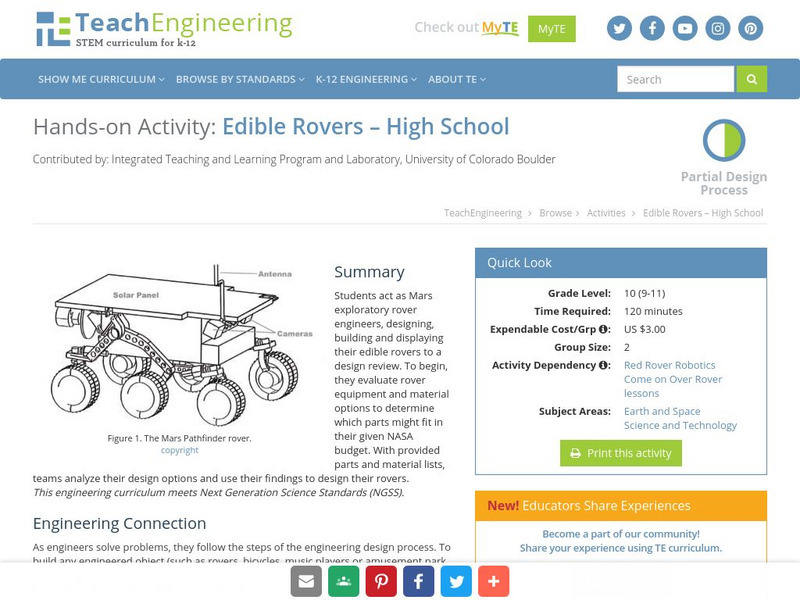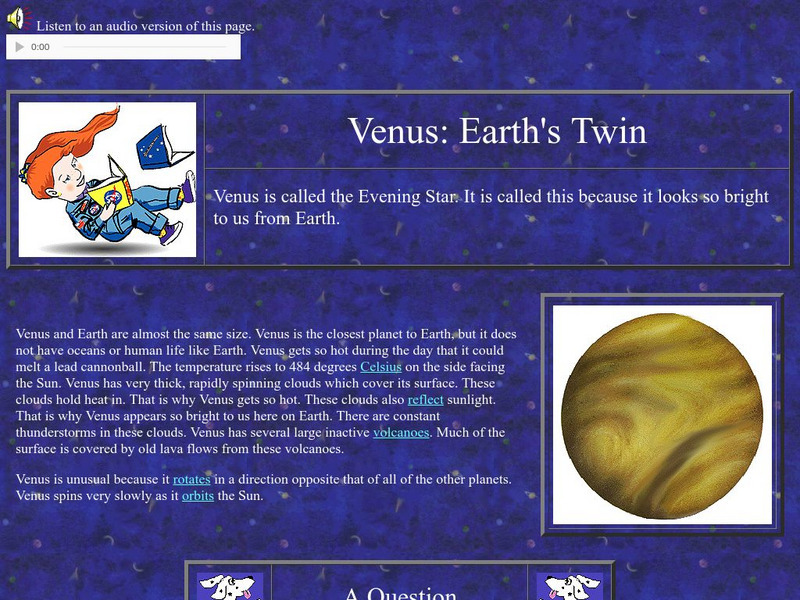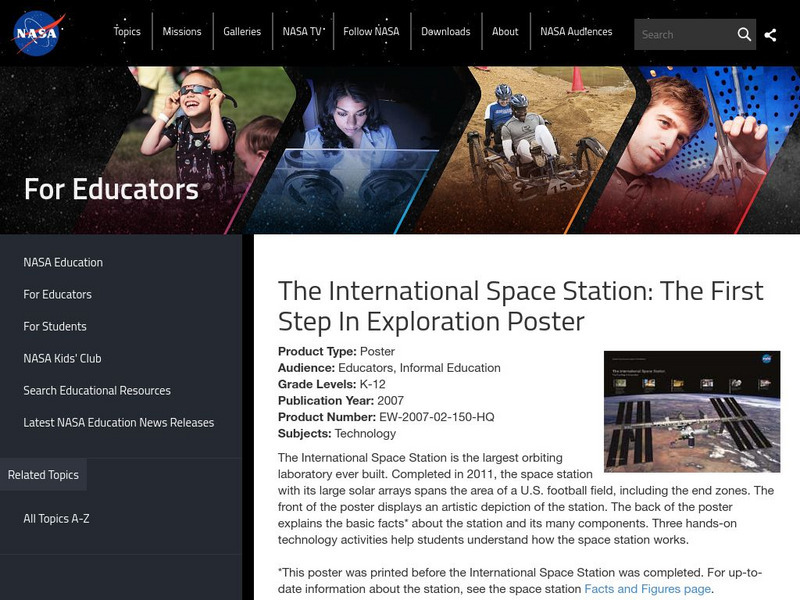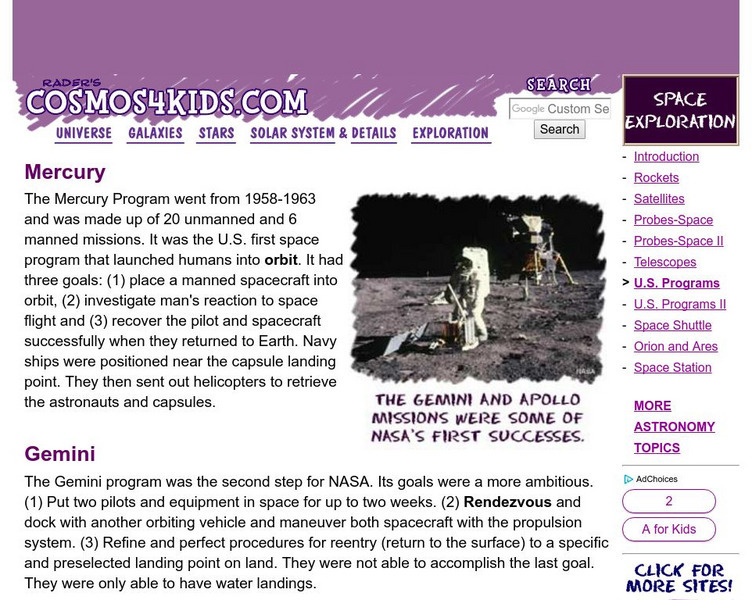Hi, what do you want to do?
TeachEngineering
Teach Engineering: Edible Rovers High School
Students act as Mars exploratory rover engineers, designing, building and displaying their edible rovers to a design review. To begin, they evaluate rover equipment and material options to determine which parts might fit in their given...
NASA
Nasa Star Child: The Planet Earth
Facts about the Earth including its orbit, its atmosphere, and its landforms. Includes a discussion question on seasons, with facts about them, and the answer. A linked page covers similar material in a "Level 2" version, and has a...
NASA
Nasa Star Child: The Planet Venus
Basic facts about the planet Venus including its temperature, its atmosphere, and its volcanoes. Includes a discussion question on temperature, with facts, and the answer. A linked page covers similar material in a "Level 2" version, and...
NASA
Nasa Star Child: The Planet Mercury
Basic facts about the planet Mercury including its size, its name, and its atmosphere. Includes a discussion question on its visibility from Earth, with facts, and the answer. A linked page covers similar material in a "Level 2" version,...
Science Buddies
Science Buddies: Project Ideas: Learn to Design an Ion Engine
The goal of this electricity and electronics science fair project is to understand how ions are used to propel spacecraft in space, and to use a NASA online simulator to design your own ion engine. The Science Buddies project ideas are...
PBS
Pbs Teachers:nasa's Return to Flight: Testing Insulating Materials
Examine online articles about the Columbia mission accident and liquid fuel propulsion. Conduct an experiment to determine the best material for insulation.
PBS
Pbs Learning Media: Bringing the Universe to America's Classrooms
WGBH in collaboration with NASA presents digital media resources you can use to teach topics in K-12 Earth and Space Science. These free resources are organized into four grade bands. Each resource emphasizes engaging students in...
PBS
Pbs Learning Media: Seasons on Earth and Mars
Compare the seasons on Earth and Mars with NASA imagery. Use this resource to visualize how the axial tilt of a planet influences its seasons and to compare data about seasonal changes on Earth and Mars. Support materials include:...
American Geosciences Institute
American Geosciences Institute: Earth Science Week: Rock Around the World
Classes from around the country collect rock samples and send them in to be analyzed by NASA scientists.
Smithsonian Institution
National Museum of Natural History: Ocean Planet
Detailed website that was a companion to a 1995 traveling exhibit of the Smithsonian. Links to lesson plans and other educational materials are at the bottom of the page. Enter the exhibition to explore the world of the ocean.
PBS
Pbs Learning Media: Earth's Albedo and Global Warming
In this interactive activity adapted from NASA and the U.S. Geological Survey, learn about Earth's albedo (the ratio of reflected vs. incident solar radiation), how pollution alters albedo, and how ice-albedo feedback may accelerate...
NASA
Nasa: The International Space Station: The First Step in Exploration Poster
This site shows a poster of the International Space Stations that can be hung up in classrooms.
NASA
Nasa: The International Space Station: The First Step in Exploration Poster
This site shows a poster of the International Space Stations that can be hung up in classrooms.
PBS
Pbs Learning Media: Characteristics of the Sun
This video segment adapted from NASA describes the basic characteristics of our star, the Sun. Includes background reading material and discussion questions. Video length: 1 min. 28 sec.
PBS
Pbs Learning Media: Earth System: El Nino's Influence on Hurricane Formation
This video segment adapted from NASA's Goddard Space Flight Center explains how and where hurricanes develop. Learn how El Nino events alter the course of atmospheric circulation. Includes background reading material and discussion...
PBS
Pbs Learning Media: Deforestation in Bolivia
This visualization adapted from NASA features two satellite images from 1984 and 2000 that show the dramatic deforestation of the Bolivian rainforest. Includes background reading material and discussion questions.
California Institute of Technology
Spitzer Science Center: Evidence for Comets
Under the heading, "Evidence for Comets Found in Dead Star's Dust" this site examines specific details of an chart/graph which demonstrates the cloud of dust involved in the white dwarf and this cloud's relation to the material...
Cosmos 4 kids
Cosmos4 Kids: Mercury
A look into NASA's exploration of Mercury. Site includes reference material as well as a video about the Apollo Mission.
PBS
Pbs Learning Media: Explore How Light Is Needed to See Things: Interactive Lesson
Explore how light moves and describe how an object in a dark space only becomes visible when light moves into the space and illuminates it. Interactive activities, time-lapse videos, and images are used to enhance student observations as...















